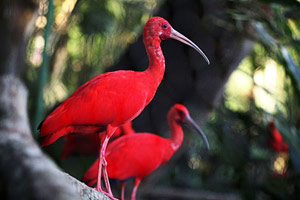| |
By Mark Rogers
For a brief period each year – during Carnival - the world’s eyes are on Trinidad. The music, costumes and revelers get our full attention. Then, when the costumes are packed away and life returns to its normal pace on the island, we turn our focus to other destinations as possible getaways for a Caribbean vacation. This is a big mistake, since multicultural Trinidad has much to offer throughout the year to the passionate traveler. Foodies will stay busy trying to sample as many ethnic dishes as possible, birders will have amazing opportunities, and cultural travelers can choose from a year-long calendar of events.
Trinidadian cooking is linked to its rich, multicultural history. At various times, the island has been occupied by the British, Spanish and French. But these occupiers had less impact on the island’s cuisine than those who did the everyday work on the island, the Africans and the East Indians.
Africans who were brought to the island as slaves had to make do with what they had, and through sheer inventiveness created a Creole cuisine rich in flavor. The stew pot was the African cook’s best friend. Some of their dishes that have stood the test of time include oxtail soup, Creole corn soup, macaroni pie, and calaloo, a spicy soup made from the spinach-like leaves of the dasheen plant.

East Indians account for about 40 percent of the population of Trinidad. Their culture and cookery has made Trinidad the center of East Indian cooking in the Caribbean. Delectable curries with chicken, crab, shrimp or duck can be found in eateries across the island. Rotis are a kind of East Indian sandwich filled with curried meat and vegetables; they’re the lunch of choice for many Trinis.
Visitors to Trinidad will find plenty of restaurants to choose from, with the widest selection being in Port of Spain. But don’t shy away from eating like a Trini and sampling dishes from local street vendors. A popular way to start the day is a street-side breakfast of doubles; these are patties filled with spicy chickpeas and topped with different relishes. Try washing it down with fresh coconut water.
An island favorite is bake and shark. Deep-fried pieces of shark are placed between two slices of fried bake - a Trini-style fried dough. You can then customize your sandwich with a variety of vegetables and a wide range of condiments - everything from ketchup to tamarind sauce. The best place to get bake and shark is Maracas Bay, which means you’ll be sitting at an open air table with the sun shining and a beach breeze blowing, sampling what has become the signature dish of Trinidad. As they say, it doesn’t get much better than this.
If you find yourself falling in love with Trinidad, seek out a dish of curried cascadura, a rare freshwater fish. Legend has it that if you eat cascadura you’ll return to Trinidad to live out your final days.
Many of Trinidad’s cultural events showcase the island’s music and food. They’re a great way to mix with the locals as they celebrate good times on the island. In addition to Carnival, culture-minded visitors should try timing their visit to Trinidad to coincide with one of the following events: Taste TNT in May, International Reggae & World Music Awards on May 28, Panyard Sensations in September, and The Trinidad and Tobago Steelpan & Jazz Festival 2011 in October.
For a complete list of T&T special events, visit www.visittobago.gov.tt.

There are two destinations on Trinidad that should be at the top of any birder’s list. One of these is the Caroni Bird Sanctuary, comprising a series of small canals and lakes. The sanctuary is about a 25-minute drive from Port of Spain. The best way to see the sanctuary, which is home to 186 bird species - is to book one of the two-and-a-half boat tours that take you through the mangroves of Caroni Swamp. For once, bird-lovers won’t have to wake up early, since the prime time to see the scarlet ibis is during the last two hours of daylight, when they come home to roost. The highlight of the trip is when the boat lays anchor and quiet settles over the group as thousands of scarlet ibis fly through the sky to roost in the trees on Caroni Island. In flight and at a distance, the birds look black against the sky, but as they settle into the trees, it’s almost as though the island is bursting into bloom with deep red blossoms in front of your eyes. It’s a magical sight and one you don’t have to be a birder to appreciate.
The Asa Wright Nature Centre covers over 200 acres and is home to more than 200 species of birds. Dedicated birders can stay at the center’s hotel to optimize their time adding names to their birder’s life list. Guided hikes are available, which are gratis to guests of the hotel staying two nights or more. The center is in the mountains of the Northern Range, seven miles north of the town of Arima.
Click HERE to see a video of scarlet ibis returning to roost on Caroni Island. |